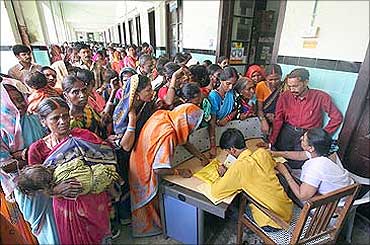Photographs: Uttam Ghosh/Rediff.com
An abysmally low government spending on health -- at $32 per capita -- characterises the poor state of healthcare in India which is facing a 'double burden' of diseases afflicting both the poor and rich classes, a new WHO report has warned.
While India's life expectancy has gone up to 65 years in 2009, up from 61 years in 2000. Global life expectancy was still higher at 68 years in 2009 as compared to 64 in 1990.
While per capita health expenditure is about $32 in poor countries, including in India, it is around $4,590 in rich countries (more than 140 times).
The high income countries consequently have 10 times more doctors, 12 times more nurses and midwifes and 30 times more dentists, the report said.
. . .
Indian govt spends only $32 per capita on healthcare!
Photographs: Reuters
With steep income disparities, India is also struggling to tackle a 'double-burden' of diseases which include infectious diseases affecting the poor on the one hand and chronic lifestyle ailments typical of fast urbanisation on the other.
The average life expectancy of a male in India is now 63 as compared to 60 a decade ago, while a female lives 66 years, in India, says the report released by the World Health Organisation ahead of the 64th World Health Assembly in Geneva.
"Life expectancy and overall health of Indians has been impressive notwithstanding high levels maternal and child mortality, high income disparities, and increasing infectious and non-communicable (heart diseases, stroke, diabetes and cancer) diseases," says Colin Mathers, Coordinator of Mortality and Burden of Disease at WHO.
. . .
Indian govt spends only $32 per capita on healthcare!
Photographs: Uttam Ghosh/Rediff.com
China, on the other hand, has improved the same to 74 years during the last 10 years. Besides, China's targeted health expenditure and growing coverage of health insurance has made a remarkable dent since 2003, the report said.
India faces high levels of maternal and child mortality, increasing burden of infectious diseases particularly among the poor, and growing incidence of non-communicable diseases in the well-to-do sections of the middle classes, the report says.
WHO's latest 'World Health Statistics 2011' offers a graphic account of how nations are spending their funds on health sector and how they are addressing major diseases. It calls on governments to spend more in a focused manner to avoid the rising mortalities from the infectious diseases that plague the poor in the society and the so-called 'non-communicable diseases of the growing middle classes'.
. . .
Indian govt spends only $32 per capita on healthcare!
Photographs: Uttam Ghosh/Rediff.com
A big part of the problem is due to vast disparities in health spending between low and high income countries. The report warns governments grimly, including India, that they are facing a 'double burden of disease'.
It involves a sudden spike in infectious diseases that cause maximum child and maternal mortality coupled with chronic non-communicable diseases - such as diabetes, heart diseases, and cancers -- caused by globalisation and urbanisation.
Despite high economic growth in the last decade, India continues to be one of the highest disease-burdened countries in the world in absolute terms.
. . .
Indian govt spends only $32 per capita on healthcare!
While the infant mortality is 50 per 1,000 lives, the mortality of children below 5 years is 66 per 1,000 lives.
Though the infant and child mortality has dropped steeply over the 10 years, it remains still high as compared to China which has seen spectacular improvements in this area.
The infant mortality in China is about 17 per 1,000 and 22 per 1000 for children below 5 years.
. . .
Indian govt spends only $32 per capita on healthcare!
"Since 2003, China has rapidly increased health insurance which contributed to significant improvements in the health sector," Ties Boerma, director of WHO's Department of Health Statistics and Informatics.
India also faces the spectre of non-communicable diseases -- heart diseases, stroke, diabetes and cancer -- which currently make up two-thirds of all deaths globally.
The report says the increase in the non-communicable diseases in India and elsewhere is due to ageing population and spread of risk factors associated with globalisation and urbanisation and coupled with increasing use of tobacco, sedentary life styles, unhealthy diet and excessive use of alcohol.







article